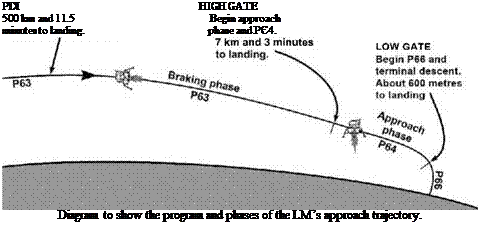Next stop: the Moon “GO FOR THE PRO”: THE LANDING BEGINS
By July of 1969, NASA had done about as much as they could to prepare for the Moon landing. On the flight of Apollo 10 two months earlier, Tom Stafford and Eugene Cernan had taken their LM Snoopy into the descent orbit but had gone no further before returning to John Young in the CSM Charlie Brown.
Where Snoopy had feared to wander, Eagle swooped in. Although the first landing attempt, flown by Neil Armstrong and Buzz Aldrin, would be ultimately successful, it was by no means a straightforward descent. Landing on the Moon was a 12-minute rocket ride from orbit with a starting speed of nearly 6,000 kilometres per hour leading to a gentle touchdown on a terrain where no prepared ground awaited the LM. In that short time, a plethora of problems were served up to the crew of Eagle that would have curled the toes of everyone involved had it merely been a simulation. The fact that they all occurred on the actual landing attempt in full view of the world, yet were successfully handled by the mission control team and the crew, is testament to their professionalism, and to the power of exhaustive simulation as a means of properly preparing people for the challenges they may face.
Programs and phases
Planners broke the descent into three parts with each controlled by a dedicated program in the computer. The first was the braking phase, when most of the spacecraft’s orbital speed was countered by the thrust of the descent engine. This was the domain of Program 63 which began 10 minutes before the powered descent. It included the engine’s ignition and continued for the first nine minutes or so of the nominally 12-minute burn while the computer worked to take the crew to a point in space known as high gate, typically 2,200 metres in altitude and about seven kilometres from the landing site. At the start of the braking phase, the LM flew with its engine pointing against the direction of travel. Then as the burn
W. D. Woods, How Apollo Flew to the Moon, Springer Praxis Books,
DOI 10.1007/978-1-4419-7179-1 10. © Springer Science+Business Media. LLC 2011
 |
progressed, the spacecraft gradually tilted a little more upright. At high gate, P64 took over.
P64 handled the approach phase of the descent. When the program assumed control, its first action was to pitch the LM further towards an upright attitude in order to enable the crew to see the landscape ahead. The point to which the computer was taking them was just on the near side of the horizon. They then flew in a manner roughly similar to a helicopter, but with the LM carefully balanced on top of the engine’s exhaust with the computer still in full control of where it was going. P64 included a method of informing the commander of where the computer was taking them, but if he deemed this to be unsuitable, then with a nudge of his controls he could instruct the computer to move the aim point. P64 was targeted to take the LM to a point about 30 metres above the surface and about five metres from the landing site. Prior to reaching this point, the crew would reach low gate, about 200 metres altitude and 600 metres short of landing.
As low gate approached, the commander was faced with a range of options. If he was completely satisfied with the job the computer was doing, he could allow it to automatically move on to P65, which could complete the landing. No commander ever allowed that, although it is said that Jim Lovell had intended to if Apollo 13 had reached this point. These competitive ex-test pilots, many of them experienced at landing on aircraft carriers, were happier to have some degree of control and steer the LM, and they all selected P66 before reaching low gate. P66 continuously throttled the engine to control their rate of descent, and the commander could adjust this rate as conditions warranted. At the same time, he assumed manual control of the LM’s attitude, which allowed him to steer the ship to a site of his own choosing. One other program, P67, was available to the commander, which gave him full manual control of the spacecraft, both the attitude and the throttle setting, but this

“Go for the pro”: the landing begins 287
option was never used. Both P65 and P67 were dropped from later versions of the LM software.










